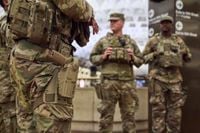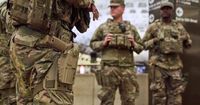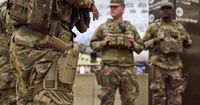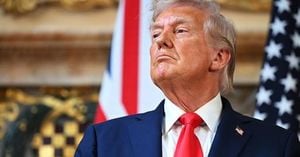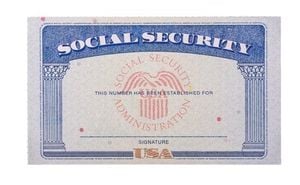On the streets of Washington, D.C., a new normal has set in. As of August 26, 2025, residents are experiencing their third consecutive week of National Guard troops and federal law enforcement patrolling their neighborhoods. The presence of these uniformed figures—now openly carrying firearms—has become a daily reality, and the city’s mood is a mix of unease, resignation, and sporadic protest.
According to reports from the Associated Press, the latest development in this ongoing federal intervention is the arming of patrol units. Until recently, the National Guard and federal officers were visible but unarmed; now, rifles and sidearms are a common sight along sidewalks and in public spaces. The shift has not gone unnoticed by Washingtonians, who are grappling with the implications of such a heavily militarized presence in their city.
On Tuesday, August 26, armed members of the South Carolina National Guard were seen patrolling inside the city’s metro system, a vivid illustration of how deeply the intervention has penetrated daily life. The AP photo gallery, curated by their editors, captures the starkness of the moment: troops in camouflage, weapons at the ready, moving through the heart of the capital.
This federal takeover began under a directive from President Donald Trump, whose order sent National Guard troops and federal law enforcement into the city. The stated goal, according to administration officials, was to ensure public safety and order. Yet, the move has drawn criticism and resistance from segments of the city’s population, who have taken to the streets in sporadic protests. Demonstrators have voiced their opposition to what they see as an unnecessary and provocative show of force.
"Washingtonians are in their third week of National Guard troops and federal law enforcement patrolling their streets, now carrying firearms and drawing sporadic protests against President Donald Trump’s directive," reported the Associated Press.
For many residents, the sight of armed troops on familiar corners is jarring. Some, like local business owner Maria Jenkins, say it feels like living in a city under siege. "I never thought I’d see military rifles outside my café," Jenkins confided to a reporter. "It’s intimidating, and I worry about what happens if tensions rise." While not everyone shares this sense of alarm, there is a palpable anxiety threading through conversations in coffee shops, parks, and on social media.
The protests, though sporadic, have been persistent. Groups of citizens have gathered near the Capitol, outside federal buildings, and along major thoroughfares, holding signs and chanting slogans. Their message is clear: they want the troops to leave, and they want a return to civilian policing and local control. Some demonstrators see the arming of patrols as an escalation, a move that risks inflaming rather than calming the city’s mood.
"There have been sporadic protests against President Donald Trump’s directive," AP noted, underscoring the fact that opposition is not limited to any single neighborhood or demographic. The protests have drawn a diverse cross-section of Washingtonians: students, business owners, longtime residents, and newcomers alike.
At the same time, there are those who support the intervention. Some residents, particularly those in neighborhoods that have experienced spikes in crime or unrest, say the presence of the Guard has brought a measure of security. "I feel safer seeing the troops," said Marcus Lee, a lifelong D.C. resident. "I know not everyone agrees, but I think we need this right now." This perspective, though less visible in the protests, reflects a deep desire for stability amid uncertainty.
Still, questions swirl about the long-term impact of the federal crackdown. Civil liberties advocates have raised alarms about the precedent set by deploying armed troops in a domestic setting, especially in the nation’s capital. Legal scholars point to the unique status of Washington, D.C.—a city without statehood, and thus subject to federal control in ways other U.S. cities are not. The deployment, critics argue, exposes the vulnerabilities of a city whose residents lack full representation in Congress and limited autonomy over their own affairs.
For the Trump administration, the move is framed as a necessary response to unrest and a means of restoring order. Officials have cited concerns about public safety, pointing to incidents of vandalism and clashes between demonstrators and police in previous weeks. Yet, the lack of a clear timeline for withdrawal has fueled speculation about the political motives behind the intervention. Some analysts see it as a show of strength ahead of the 2026 midterm elections, while others worry it could become a fixture of urban governance if left unchecked.
The presence of the South Carolina National Guard in the metro system is particularly notable. The city’s subway, a symbol of everyday life and mobility, has become a stage for the broader drama unfolding in Washington. Commuters now share space with armed troops, a reality that would have seemed unthinkable just a month ago. For some, it’s a reassurance; for others, a source of distress.
Photographs from the scene, distributed by AP photo editors, capture moments of tension and calm: a soldier standing watch as children play nearby, a protester holding a sign as a patrol passes, a family hurrying through a metro station under the gaze of uniformed guards. The images tell a story of a city adapting, uneasily, to extraordinary circumstances.
As the third week of the federal presence draws to a close, Washingtonians are left to wonder what comes next. Will the troops remain, and for how long? Will the protests continue, or fade as residents adjust to the new status quo? And what will be the lasting legacy of this summer’s intervention—greater security, deeper divisions, or something else entirely?
For now, the city moves forward, each day marked by the rhythms of patrols, protests, and the persistent hope that normalcy might one day return. The story of Washington’s federal takeover is still being written, its outcome uncertain, its impact felt in every corner of the capital.
